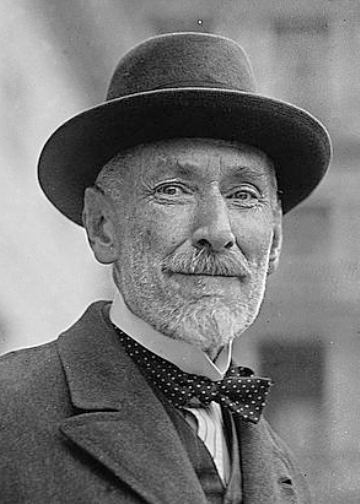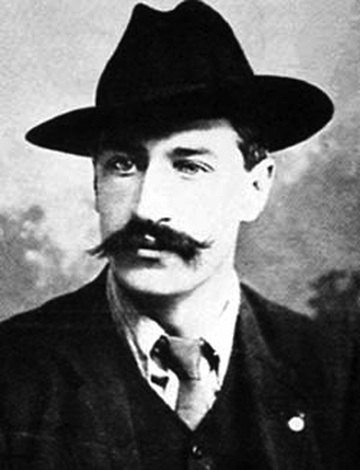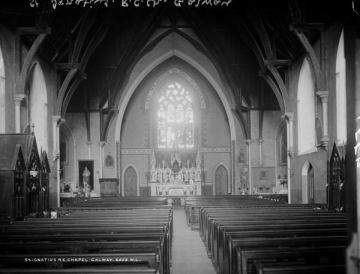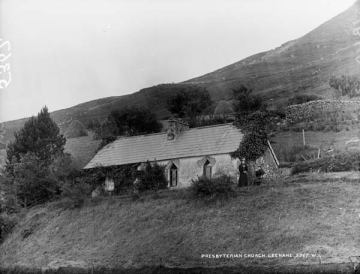Politics and institutions in Galway in the early 20th century
View the photo galleryFollowing the extensions of the franchise in the late nineteenth century, the county of Galway was represented by five members of parliament (MPs) at the House of Commons in London. One MP was returned for Galway city itself, the four others represented the east, north and south of the county and Connemara, respectively. In 1911 all seats were held by the nationalist party.
The last successful unionist candidate had been elected in 1900. Indeed, when he succeeded to a noble title Horace Plunkett, living in Foxrock in Dublin by 1911, unsuccessfully contested a seat as a unionist candidate. Galway was avowedly nationalist in its popular politics, though the county did of course have its local gentry including Lord Killanin (see return for his household).
The county’s most prominent MP was Stephen Gwynn, elected following a by-election in 1906. Gwynn was one of John Redmond’s inner-circle of supporters and as a literary man had strong connections with the Gaelic revival movement. Gwynn’s election was not initially popular – he was catapulted into the seat by John Redmond and beat the local favourite, landlord John Shawe Taylor, who was the chairman of the Galway Development Association
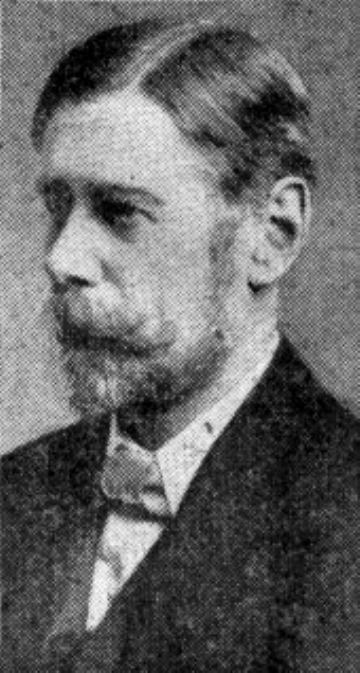
A photograph of Stephen Gwynn from The War Illustrated, 31 July 1915. The caption which accompanied the image read: "Lieut. STEPHEN GWYNN, B.A., M.P., Connaught Rangers, famous author and journalist, who has written over twenty books including novels, essays and verse".
(http://images.google.ie/ )
Gwynn was later to become Redmond’s biographer after his death. He was also one of five nationalist MPs to serve in the British Army in the First World War. Son of a noted Anglican cleric, he was father of Denis Gwynn and Aubrey Gwynn, the academics, and his brother Edward John Gwynn became provost of Trinity College in Dublin. William O’Malley, the MP for Connemara was also a prominent Irish Party member and the upcoming MP Richard Hazelton was also to represent the county.
Following the local Government Act of 1898, Galway city was presided over by an Urban District Council and the county presided over by the County Council (see employee Walter Seymour) with individual towns afforded district councils. The medieval Galway Corporation had been abolished in 1830 and replaced by a series of town commissioners. It was not to be re-established until 1937.
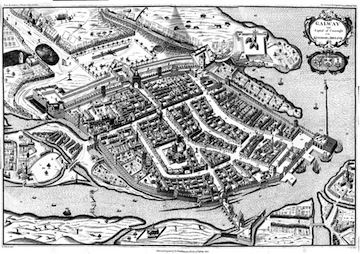
This map of 1651 shows the walled city (North is to the left). The River Corrib is in the foreground, crossed by what is now "O'Briens Bridge", leading to Salthill.
(http://en.wikipedia.org/wiki/History_of_Galway)
Galway was not immune from the political upheavals of the early twentieth century. Edward Martyn, of Tullira castle, who co-founded Sinn Féin with Arthur Griffith was from the county. Sinn Féin had noted electoral success in the county at local level, particularly in alliance with labour interests.
In 1911 the Irish Trades Union Congress was held in Galway city, perhaps a strange decision as the city had not yet established a trades council. The first such body was established in the second half of the year following the visit of the national trade unionists. Issues discussed included recent amendments to the old age pension act, unemployment, the campaign for an 8-hour day, trades’ boards and the Osborne judgement which prevented trade unions using their funds for political purposes. Following a rancorous debate involving William Walker and Jim Larkin, the Congress rejected by 32 votes to 29 a proposal to establish a labour party in Ireland, choosing to restate its support for the British Labour Party. A motion to support the establishment of an Irish Labour Party was passed the following year.
Without a noted industrial base, labour in Galway was slow to organise and what efforts there were were based among workers in road and railway building though in 1911 there was a short strike among newspaper boys. The first manifestation of labour activism in the county was the formation of the Galway Labourers’ Society in 1890 among the city’s dockers, and trade union activism and strikes were a feature of the construction of the Galway to Cliffden railway line. Labour candidates also won seats on the Ballinasloe urban district council in 1899.
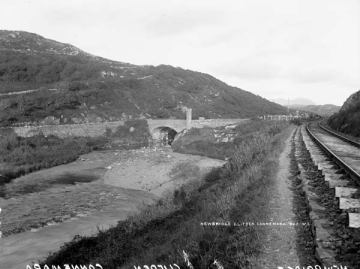
A view of the railway line at Clifden, Co. Galway ca. 1900. Strikes were a feature of the construction of this railway line which linked Clifden with Galway city
(NLI, LROY 00863)
The congress was attended by James Larkin, but Galway was to prove relatively immune to his charms. Despite the Galway General Workers’ and General Labourers’ Union being formed following the Congress, it was later amalgamated into the British-based union, the National Union of Dock Labourers, with the NUDL holding off the rise of Larkin’s Irish Transport and General Workers Union until after the Great War. The union’s first secretary William O’Halloran was to become the first Labour councillor elected to the urban council. Luke Joseph Duffy, later a Labour Party General Secretary and Senator became branch secretary of the Irish Drapers’ Assistants Association. He was fired from his position in Moon's Store in 1916 because of his trade union activity.
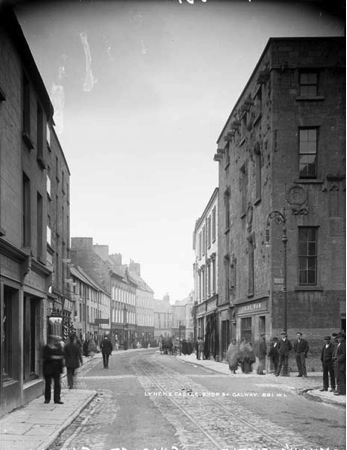
Lynch's Castle, Shop St., Galway City, Co.Galway
(L_ROY_00881)
One of the other great issues of the period was the campaign for women’s suffrage. Gwynn for example, was a noted supporter of suffrage. Despite women being afforded the vote in local elections in 1899 progress was slow, though Galway County Council appointed Ms Aleen Cust as veterinary inspector in Mountbellew. In 1908 Monica McDonogh was the first woman elected as a poor law guardian in Oughterard. The Women’s National Health Association had branches in Galway, Ballinasloe, Clifden, Killkerrin and Letterfrack (see return for the Industrial School at Letterfrack).
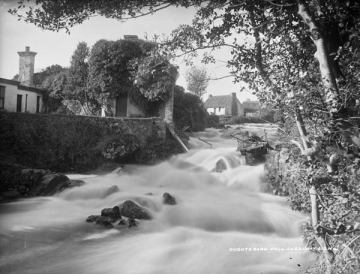
The falls at Oughterard ca. 1900. In 1908 Monica McDonogh was the first woman elected as a poor law guardian in Oughterard
(NLI, LROY 00813)
The year 1911 saw a visit to the town of the prominent British suffragist, Christabel Pankhurst. Immediately following Ms Pankhurst’s address, a branch of the Irish Women’s Suffrage League was established in the city. By 1913 there were reported branches in Tuam and Ballinasloe. This was to lead to the establishment of the Connacht Women’s Franchise League in 1914. A noted success of the Pankhurst visit was that Galway Urban District Council passed a motion in support of women’s suffrage in October, much to the satisfaction of the suffrage movement. While suffragists in Connacht remained committed to peaceful methods of campaign, one Galway suffragette, Kathleen Kean, was arrested in the infamous Bow Street riots in London.
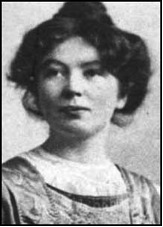
British suffragette, Christabel Pankhurst, who visited Galway in 1911.
(http://images.google.ie)
Continuing disputes over land led to the establishment of the Galway Secret Society. By 1907 it was being directed by a Craughwell republican, Tom Kenny. Its aim according to a local RIC inspector writing in 1910 was ‘to effect the rapid redistribution of grazing land among the rural poor.’
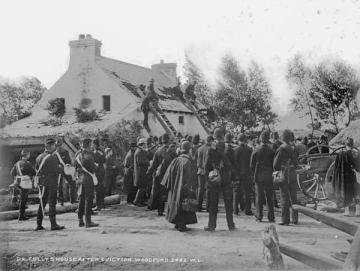
The aftermath of an eviction: a crowd gathers around the house of Dr. Tully in Woodford, County Galway ca. 1900. Disputes over land were a feature of rural Galway life during this period.
(NLI, LROY 02482)
Galway’s Renmore was also the home base of the Connaught Rangers and the regiment recruited strongly from Galway and surrounding counties. The regiment, formed in 1882 by the amalgamation of the 88th and 94th foot, played an important role in social life of the city. About 2,500 of its members lost their lives in the first world war.
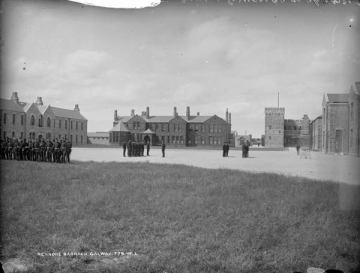
Members of the Connaught Rangers are put through their paces at Renmore Barracks ca. 1900
(NLI, LROY 00779)
Most of the soldiers were Catholics. Galway was a predominantly Catholic county (see return for Thomas Crean Lynch, Catholic curate at Esker); 97.8% of the population returned themselves as Catholic (see return for the Sisters of Mercy in Loughrea) . The remaining minority comprised mostly members of the Church of Ireland (see Richard Bevan of Tuam), Episcopalians (see Catherine Lopdell and family of Athenry), Quakers (see Kathleen Kenny of Kylemore in a mixed marriage) and Methodists (see Ann Campion of Ballinasloe).
Galway was a predominantly Catholic county, but there were significant minorities, and also, as in other urban centres, a number of different religions in close proximity: see a lodging house in Tuam where members of the Catholic, Protestant and Presbyterian faiths lived together.

